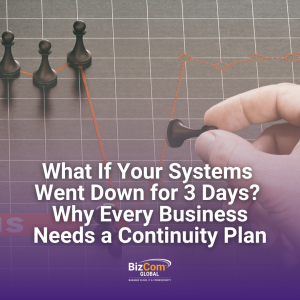
A no-nonsense guide for leadership on what should be in your business continuity plan — and why waiting is a risk you can’t afford.
Imagine it’s Monday morning. Your systems are offline.
No email.
No client records.
No access to files.
No phones.
No clue when it’ll be fixed.
Now imagine this lasts for three full days.
What’s your plan?
If your answer is anything short of “Here’s what we do, step by step,” then you don’t have a business continuity plan — you have wishful thinking.
The Myth: “It Won’t Happen to Us”
Most business leaders don’t intentionally skip continuity planning. They just don’t think it applies to them — until it’s too late.
But system outages don’t just happen to big corporations or cyberattack victims. They happen because:
A cloud provider has downtime
A server update fails
A ransomware attack locks your data
A power surge corrupts your network
A human error deletes mission-critical files
- A natural disaster hits your office
You don’t need to be hacked to be knocked offline.
What’s at Stake in a Multi-Day Outage?
Let’s talk real consequences:
Revenue loss — Every hour your systems are down is an hour you can’t generate income
Client trust — If clients can’t reach you or experience poor service, they may not come back
Operational delays — Projects stall, deadlines are missed, and productivity grinds to a halt
Regulatory penalties — If you’re subject to HIPAA, PCI DSS, or FTC Safeguards, downtime without proper documentation could trigger fines or audits
- Team morale — Uncertainty and scrambling during a crisis creates frustration and burnout
What Should Be in a Business Continuity Plan?
A good continuity plan doesn’t need to be complex — it needs to be clear, accessible, and tested. Here’s what it should include:
Key Systems & Priorities
What systems are most critical to business operations? What absolutely needs to come back online first?
Communication Plan
Who talks to staff, clients, vendors, and stakeholders? Through what channels?
Recovery Roles & Responsibilities
Who does what? Who’s in charge of initiating the plan, contacting providers, and executing recovery?
Alternative Workflows
If your systems are down, how does your team continue to operate — even at reduced capacity?
Backup & Restore Process
Where are backups stored? Who has access? Has the restore process been tested?
Access Plan
Can your team work remotely if needed? What tools or permissions will they need?
Review Schedule
How often is the plan reviewed and updated? When was the last time it was tested?
You Don’t Need to Panic — You Need to Prepare
A business continuity plan isn’t about predicting the exact problem. It’s about reducing uncertainty when something unexpected happens.
The question isn’t if you’ll experience disruption. It’s when — and how fast you can recover.
Final Thought: You Can’t Afford to Wait Until Things Break
If your systems went down for 3 days, what would it cost you?
If you don’t know, that’s your sign to take action — now.
Want help building or pressure-testing your continuity plan?
Schedule a Business Continuity Planning Session with BizCom Global — and let’s make sure your business is ready for anything.


